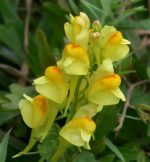 Also called butter-and-eggs, and wild snapdragon, yellow toadflax is a herbaceous perennial and a member of the plantain family, Plantaginaceae, that also includes snapdragon, foxglove, and turtlehead. It is native to Europe and Asia but was introduced into US in the late seventeenth century as an ornamental and medicinal plant and can now grow throughout most of the country. Plants prefer sites with full sun and dry lean soil, and can be found in rangeland, riparian areas and a variety of disturbed sites such as pastures, old fields, roadsides and railroads. Description: Growing from a long taproot with shallow rhizomes spreading in all directions, yellow toadflax reaches one to feet tall and has an upright stem with few branches and many pale green leaves. The leaves are linear, up to 2.5 inches long, hairless, sessile, and have smooth margins. The flowers appear in terminal spikes up to nine inches long beginning in early to mid-summer for about a month. Each snapdragon-like flower is about one inch long and and has two large lips and a yellow spur that hangs down. The lips are pale yellow with a contrasting bright orange bearded throat. Seeds capsules contain many small brown flattened seeds surrounded by a papery wing with a notch on one side. Plant spread by seeds and rhizomes, and usually form colonies.
Also called butter-and-eggs, and wild snapdragon, yellow toadflax is a herbaceous perennial and a member of the plantain family, Plantaginaceae, that also includes snapdragon, foxglove, and turtlehead. It is native to Europe and Asia but was introduced into US in the late seventeenth century as an ornamental and medicinal plant and can now grow throughout most of the country. Plants prefer sites with full sun and dry lean soil, and can be found in rangeland, riparian areas and a variety of disturbed sites such as pastures, old fields, roadsides and railroads. Description: Growing from a long taproot with shallow rhizomes spreading in all directions, yellow toadflax reaches one to feet tall and has an upright stem with few branches and many pale green leaves. The leaves are linear, up to 2.5 inches long, hairless, sessile, and have smooth margins. The flowers appear in terminal spikes up to nine inches long beginning in early to mid-summer for about a month. Each snapdragon-like flower is about one inch long and and has two large lips and a yellow spur that hangs down. The lips are pale yellow with a contrasting bright orange bearded throat. Seeds capsules contain many small brown flattened seeds surrounded by a papery wing with a notch on one side. Plant spread by seeds and rhizomes, and usually form colonies.
Control: The extensive root system with rhizomes makes the plant challenging to control. Hand pulling seedlings before they develop rhizomes is effective. Shallow cultivation for two or more years or covering with a dense mulch such as newspaper or cardboard are also effective. Mowing plants before seed set will eliminate seed production but may stimulate spread by rhizomes. and lateral roots. In severe cases herbicides can be used although many are ineffective. Picloram, chlorsulfuron, and a mix of 2,4-D plus dichlorprop have shown promise depending on the existing desirable vegetation. Glyphosate has also shown promise but will kill other vegetation that it contacts.